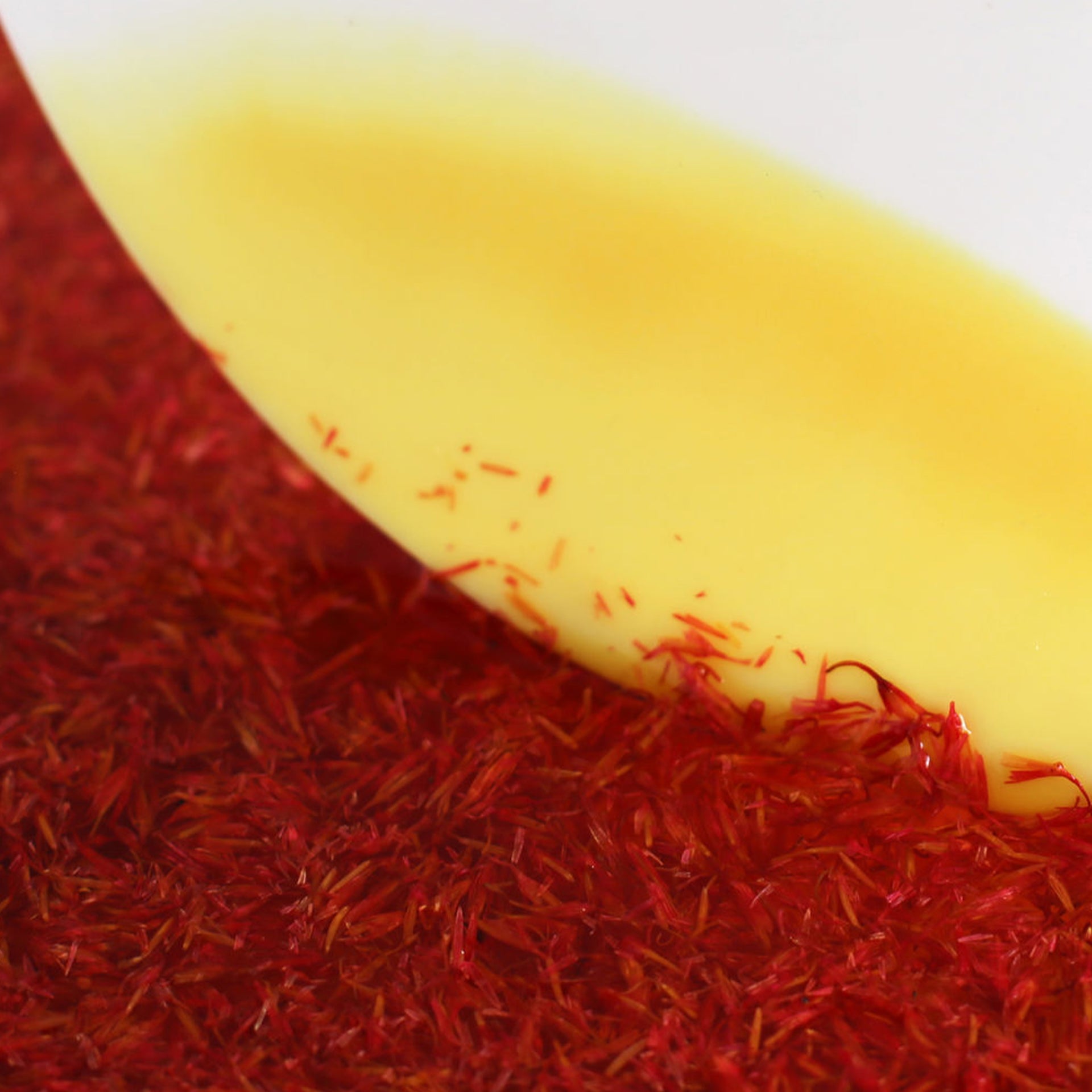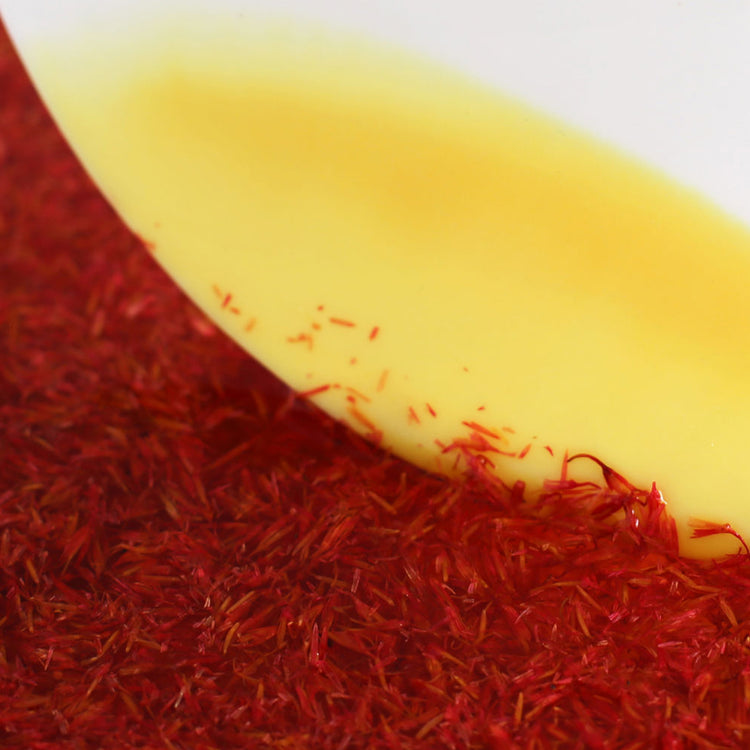Saffron is a spice of contradictions.
For starters, it comes from a purple flower, with red stigmas, that yields a deep yellow- orange colour. It is much sought after by humans, and yet we have selectively bred it to such an extent that it cannot reproduce or survive without our help.
It was originally intended as a flavour enhancer but ended up as a clothes dye, medicine, perfume, magic potion and aphrodisiac to name just a few. So what is it about this particular spice that has led us to steal, murder and even start wars just to acquire it?
Well, to answer that, we first need to do a little digging.
FOOD FOR THOUGHT

Saffron is the dried stigma of a particular autumn flowering crocus called Crocus sativus, first cultivated in the Bronze Age in Greece.
Saffron is the dried stigma (aka the part of the flower that germinates pollen) of a particular autumn flowering crocus called Crocus sativus.
It was first cultivated in the Bronze Age in Greece, and over the millennia has been selectively bred to maximise the length of the three stigma in each flower. Ironically, this process has rendered the plant entirely sterile, and now Saffron can only be propagated by human hands.
Despite this, its cultivation continued apace spreading eastwards to Persia and China, and westwards through Europe and finally to America. Today, Iran is responsible for 85 percent of global production and Persian saffron is widely regarded by the cognoscenti as being the best in the world.
Initially, its subtle earthy / grassy flavor and sweet floral aroma saw it used primarily for cooking and it quickly became integral to many famous regional dishes. Think Provençal bouillabaisse, risotto Milanese, Cornish saffron buns, Persian pilafs, Valencian paella, and, perhaps most famously, Indian biryanis.
Indeed, the use of Saffron has been documented right back to the Middle Ages as a food colouring, as this 14th Century recipe for swan illustrates all too graphically – “Once the bird is on the fire, you must “glaze it with saffron; and when it is cooked, it should be redressed in its skin, with the neck either straight or flat. Endorse the feathers and head with a paste made of egg yolks mixed with saffron and honey.” - Le Viandier de Taillevent.
COLOURFUL HISTORY

Saffron is an overwhelmingly positive colour that signifies happiness and success, and wearing it is said to enhance both your personality and confidence.

As well as being highly-prized for its distinct taste, it was also much acclaimed for the striking golden hue it bestowed on the dish. Unsurprisingly, it wasn’t long before enquiring minds began to wonder if that same golden colour might be imparted to fabrics and garments.
Saffron is an overwhelmingly positive colour that signifies happiness and success, and wearing Saffron is said to enhance both your personality and confidence. Persian Emperors in the 10th Century B.C. were the first to wear saffron for their robes of state and it has also been found interwoven into ancient Persian royal carpets and funeral shrouds.
500 years later it was adopted by the Buddhist monks of Asia to dye their robes, and in the process, saffron acquired a symbolic meaning of simplicity and detachment from materialism.
In India, Saffron gained great significance to Hindus, known as both the colour of fire and also symbolic of knowledge burning up ignorance. When India gained its independence in 1947, Saffron was chosen as one of the three colours of the Indian national flag, representing the strength and courage of the country.
POSH SPICE

Each flower blooms for only one week a year, and produces only three strands of stigma. Harvesting can only occur mid-morning, when the flowers are still closed in order to protect the delicate stigmas.
Whilst interesting, none of this explains why Saffron became so damn expensive. And when we say expensive, we mean astronomical! Saffron is easily the most expensive spice on Earth, costing as much as $16 for a single gram (aka $16,000 / kilogram!), approximately 20x more expensive than Vanilla beans, the world’s second most bougie spice.
And the reason is simple – Saffron is incredibly labour-intensive.
For starters, each flower only blooms for one week a year, and produces only three strands of stigma per flower. These strands are extremely fragile, which necessitates the flowers being harvested by hand, which can only be done mid-morning, when the flowers are still closed in order to protect the delicate stigmas.
It takes 210,000 stigmas to make half a kilo of saffron, and over 200 hours of back-breaking labour to pick them, so you can start to appreciate why it has acquired such a hefty price tag.
With Saffron being as valuable as it is, it won’t come as any surprise to learn that for thousands of years humans have viewed it as a kind of wonder drug. It pops up in history in many guises including, deodorants, paints, lipsticks, magic potions, divine offerings and as a universal cure all.
Supposedly, Cleopatra and Alexander the Great both liked to bathe in saffron-infused baths, though for vastly different reasons. Cleo liked to wallow in saffron-infused mare’s milk, believing that it would enhance her sexuality to prospective suitors, whilst Alex used it more prosaically, to cure his war wounds.
Both the Romans, and Cardinal Wolsey (royal advisor to Henry VIII) used saffron as a sort of rudimentary air freshener, scattering it on floors to get rid of the pungent smells that undoubtedly proliferated in both eras.
But it is undoubtedly in the field of medicine that Saffron has enjoyed the greatest use, if not the greatest success. Variously, it has been used by traditional healers for everything from heartache to haemorrhoids, appetite suppressant to aphrodisiac.
Modern studies have shown the high levels of antioxidants found in saffron may help ward off inflammation in the body and that it may be helpful in treating sexual dysfunction and depression. However, the jury is still out as to whether some of the health benefits attributed to Saffron, including as a cure for both cardiovascular disease and cancer, actually have any substance to them.
SCARY SPICE

In medieval times, Saffron was even prescribed (erroneously) as an antidote for the bubonic plague. This caused demand to skyrocket in Europe, and saffron was imported by shipload from Mediterranean islands such as Rhodes.

In medieval times, Saffron was even prescribed (erroneously) as an antidote for the bubonic plague. This caused demand to skyrocket in Europe, and saffron was imported by shipload from Mediterranean islands such as Rhodes.
One such cargo, worth $500,000 in today’s money, was stolen by a group of nobleman, and the ensuing bout of saffron piracy lead to the 14 week ‘Saffron War’.
Later, the rampant adulteration of saffron lead to the Safranschou code, under which adulterers (of saffron, not the other kind) could be fined, imprisoned or even put to death. Like the unfortunate Elss Pfnognerin, who was buried alive, covered in her own saffron. True story.
Being so expensive, saffron is never far away from the news. In fact, as recently as this week, unscrupulous Spanish “dealers” have been busted by Europol for importing Iranian Saffron, bulking it out and selling it as the highly-prized Spanish variant.
ADD SOME FLAVOUR TO YOUR WARDROBE WITH DEEP SAFFRON
LIMITED EDITION 150 PIECES FOR MEN + WOMEN.
Whether you eat it, use it to dye your clothes, use it as a medicine or even as an aphrodisiac, there’s no denying the hold Saffron exerts over our lives. And it would seem, that even though it is prohibitively expensive, we simply can’t afford to live without it.











